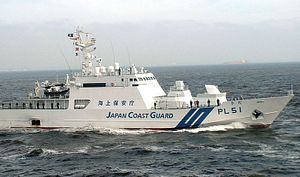Chinese and Japanese officials are expected to meet for high-level talks on maritime issues in July like establishing a “hotline” between the two countries to diffuse potential unintended clashes. The new talks are a positive development between countries that regularly face off in the East China Sea, and as Japan increasingly expands its operations in the South China Sea. However, the history of similar maritime dialogues between China and the United States should caution against expectations that they will lead to meaningful diplomatic breakthroughs, or even a moderation of risky Chinese military behavior.
China disputes Japan’s administration over the Senkaku islands in the South China Sea, which it calls the Diaoyus. Since the Japanese government took over the Senkakus from private Japanese owners in 2012, China has regularly challenged Japan’s administration over them by sending hundreds of fishing and coast guard vessels to make incursions in the waters around the islands. Nor are China’s incursions limited to the seas. The Japanese Air Self Defense Force has scrambled fighters to intercept approaching Chinese jets over 1000 times in the past 12 months.
Potential for a serious incident between the two countries is not theoretical. The 2001 collision between a U.S. Navy surveillance plane and an intercepting Chinese fighter demonstrated the risk of jockeying warplanes. In 2010 a Chinese fishing trawler repeatedly and intentionally rammed two Japanese Coast Guard cutters near the Senkakus and the Chinese captain’s subsequent arrest sparked an intense diplomatic row. Footage of a 2012 incident between the Japanese Coast Guard and Chinese activists trying to land on one of the Senkaku islands shows the Japanese ships trying to divert the Chinese boat with firehoses and eventually physically shouldering it away.
The Chinese ships in these incidents were unarmed, but similar faceoffs with the Chinese Coast Guard or Maritime Militia vessels that regularly loiter in the waters around the Senkakus could escalate with greater levels of force (though far less than an incident between warships).
Recognizing this potential, China and Japan began what was intended to be a series of dialogues on maritime issues in 2012, but China called them off in protest of Japan’s nationalization of the Senkaku islands later that year. The talks resumed in 2014 and last September Japanese Prime Minister Shinzo Abe and Chinese President Xi Jinping agreed to pursue discussions on a hotline between the governments, though Japan had pushed to institute a communication mechanism as early as possible.
China’s decision to cancel the talks for two-years as a diplomatic protest and Japan’s comparatively greater eagerness to establish the hotline mirrors the United States’ experience pursuing bilateral maritime talks with China and attempts to establish rules of behavior for their armed forces.
The United States and China concluded the Military Maritime Consultative Agreement (MMCA) in 1997 as a mechanism to discuss maritime and aviation safety in annual plenary meetings. However, the agreement established neither emergency communication protocols nor rules of professional conduct to prevent dangerous incidents like the Cold War INCSEA agreement between the United States and Soviet Union did. As a result, critics dismissed the agreement as merely a resolution to “talk about talking.”
Despite the low stakes of the annual MMCA meetings, China declined to hold plenary meetings for several years in protest of U.S. arms sales to Taiwan. But following several serious incidents like the harassment of U.S. surveillance vessels in 2009, the meetings were reestablished and the two sides made progress towards standards of conduct and communications protocols for their ships and aircraft to prevent dangerous incidents. The resulting memorandums of understanding (MOUs) between the U.S. and Chinese militaries were signed in 2014 and expanded in 2015.
Like the Cold War INCSEA agreement with the Soviet Union, the MOUs seemed to bind the two countries to safe practices that would prevent the possibility of a serious accident or incident between their ships or aircraft. However, unlike INCSEA, whose standards were written with obligatory language like “shall,” the MOUs the United States signed with China are written with voluntary language like “should,” preserving the option not to follow it. In the two years since the aviation protocols were finalized, Chinese planes have repeatedly engaged in unsafe maneuvers supposedly banned by the MOUs around U.S. aircraft, including two dangerous intercepts just last month.
Given this history, as well as China’s successful blocking of a multinational agreement for the safe conduct of warships and aircraft that encounter each other until its language was made explicitly voluntary and non-legally binding, Japan should temper its expectations for how much bilateral talks with China will prevent future maritime incidents or crises.

































